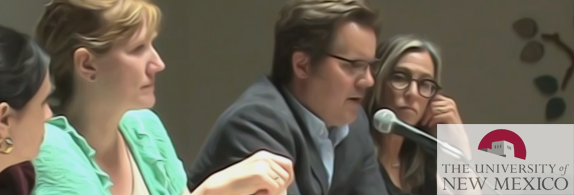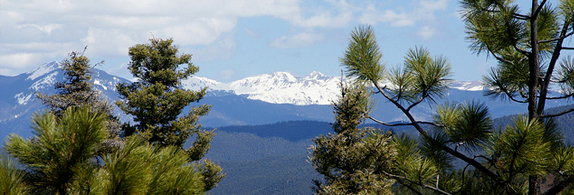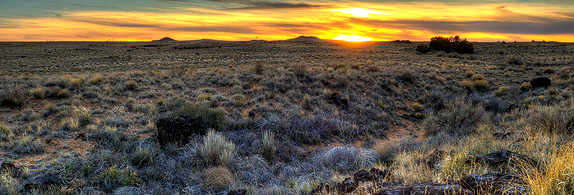Moving Forward: Healthy Police, Healthy Community

While Albuquerque awaits the outcome of the snail’s pace negotiations between City Hall and the U.S. Department of Justice about reforming the violence prone Albuquerque Police Department, it’s instructive to look back at a public discussion held last April at the University of New Mexico.
Under the auspices of the Office of Academic Affairs, UNM held a thought- provoking, information-packed public conversation in the atrium of the Student Union Building to a packed house about police violence, mental health care, and homelessness in Albuquerque.
It took place almost a month after police and citizens confronted each other in numerous encounters downtown and around UNM, protests that produced photographs of armored horses, police in riot gear, and tear gas dispersing crowds that could well have been taken during the Hong Cong riots last week.
The UNM panel discussion was organized and moderated by Virginia Scharff, Associate Provost for Faculty Development, Director of the Center for the Southwest, and Distinguished Professor of History at UNM. It presented a broad spectrum of opinion and has much to tell us about the multiple conditions, worldviews and frustrations facing our city.
The most fascinating clash of realities were between those who blame the police for police violence and those who blame Albuquerque for being a violent city and causing the police to be violent. Many citizens are now so frightened of the police and so disillusioned with their practices and paramilitary nature that community involvement with police is next to impossible.
The panel was comprised of Vicente Alvarado, a retired 20 year veteran of the Albuquerque Police Department (APD) who now teaches self-defence; Caroline Bonham, a psychiatrist who directs UNM’s Center for Rural and Community Behavioral Health; David Correia, a UNM history professor and author who writes about police violence; Maria B. Velez, a UNM professor of sociology who studies how racial and economic inequality pattern urban crime in cities, and Karen Fischer, a retired civilian employee of the APD who worked in community relations and public safety issues.
The panel was an eye-opening moment of community outreach by UNM and serves as a model, in my mind, for an ongoing, formal, perhaps weekly, program of community discussion and involvement that UNM could instigate in the months ahead. Dozens and dozens of issues on campus and in the city and state could benefit greatly from this kind of focused panel conversation and audience response.
The format opened up many possibilities. The panelists gave opening statements. Then each of them asked a question the other panelists were to answer with the questioner having a chance to comment. It revealed the spectrum of opinion as clearly as any panel I’ve seen.
It’s particularly important to watch a video of the panel now, as discussions of police oversight, the DOJ report, shocking new revelations about the avoiding the use of video cameras, and the James Boyd shooting have come to the surface. Boyd was described by one of his police killers as a “f..king lunatic” before being shot.
Unhappily the forum did not receive wide public attention and comment outside UNM’s campus. TV didn’t cover it, nor did the Journal. And regrettably, I didn’t write about it in Provincial Matters.
But for someone like me who wants to see the university more involved in community issues, “Moving Forward” was a shining moment.
While it’s best to get the full exchange on video, the general tone and direction of the conversation is clear. It began with Professor Scharff saying UNM believes universities are places where “respect, wisdom, and good ideas emerge even in the midst of profound crises of trust and legitimacy” such as those facing City Hall today. She described the university as a “stakeholder in our community” with a desire to help people representing often deeply conflicting views to find “common ground.”
In essence, three themes emerged. First, the APD view: that the police are working against terrible odds in a terribly violent town that outsiders from Washington don’t and can’t comprehend. Second, the citizen/victim view: that the U.S. Department of Justice has found APD operating on a system that condones unconstitutional use of lethal and non lethal force against largely defenseless people, the homeless and the mentally ill, with an alarming number of fatal and non fatal shootings. Third, the mental health and sociological view: that the behavioral health care system, lack of sufficient community policing, and the criminalization of homelessness contribute to a situation in which not only are citizens afraid of the police, but that police intervention into what amounts to mental health crises are not sufficiently supervised by crisis management professionals.
Being familiar with and sympathetic to the last two views, I found the police perspective fascinating and revealing. I served for sometime as a police beat reporter for the Albuquerque Tribune in the l960s and know that a majority of officers in those days would proudly say they had never drawn their weapon in the line of duty. Drugs were moving through here by the carloads every day and violence came with that traffic, as it always does. During my tenure on that beat there were rashes of killings at convenience stores and hotels, and an alarming uptick in the stealing of copper wire. Property crime was high. And Albuquerque drivers were as crazy as ever. A state police officer was murdered by a motorist he’d pulled over. And it was, in the eyes of many, always Police Protection in the Heights and Law and Order in the Valley.
But there was nothing like the on-going, unconstitutional lethal and nonlethal police violence that has evolved here over the last five years in particular, but which stretches back into the 80s following what amounted to Ronald Reagan’s destruction of the American mental health system, with the closing of countless mental health institutions.
You’ll see the police representative on the panel say that officers work in a violent city, that there are over 100 gangs in our town, and that police are always in a “reactionary role,” responding to situations in which violence is imminent. Police don’t cause the violence, they respond to it, the police view goes. And if folks didn’t point guns at them and threaten them they wouldn’t be shot. The implication was, from that vantage point, that the police are asking “where do those guys from the DOJ get off coming into our town, which they know nothing about, and trying to tell us what to do?”
It’s a powerful insight into why the negotiations between the police, City Hall, and the DOJ are going so slowly. Clearly the DOJ is meeting intractable opposition every step of the way.
If you want a clearer understanding of what’s going on in our community at the moment watch “Moving Forward: A Conversation about Police Force, Justice and Community.” It’s hard not to see what’s going on. You can see the video in its entirety below:
New Mexico Forests and the Midterm Elections

The Union of Concerned Scientists and the Rocky Mountain Climate Organization issued last month an alarming, depressing, and in some ways unsurprising report on the risk of climate change to the health of Rocky Mountain forests all though the mountain west, including New Mexico.
As I was reading the report I was struck by my overwhelming reaction. How can anyone who conceives of climate change as being one of the greatest dangers facing our times vote for people who don’t believe climate change even exists and who lobby endlessly to promote a set of doubts and views of scientists-for-hire bought and paid for by the fossil fuel industry? Voting for such people out of ignorance, out of social and cultural dogma, or for reasons of economic ideology is rather like taking little doses of arsenic to make yourself immune to the poison while you help kill everyone else off. Except there’s no immunity from climate change.
This is all particularly clear in the race for New Mexico State Land Commissioner, a position which oversees the care and revenue production of 9 million acres of surface and 13 million acres of subsurface holdings.
With the mountain forests of the west falling prey to climate induced insect infestations, increased diseases and drought, do we really want to elect a person to oversee our state lands who belongs to a political party that has at its power base people who don’t believe in climate change and who think public lands should be auctioned off? My answer is obvious. That’s why I’m voting for incumbent Ray Powell.
So next month’s election in New Mexico is made all the more pertinent and poignant by the September report on the Rocky Mountain forests.
The Union of Concerned Scientists (UCS) estimates that some 10 million trees have died in Rocky Mountain forests in the last 15 years. That doesn’t even account for all lost trees in all the other mountain ranges and their forests in the west.
The UCS makes no bones about what’s causing this catastrophe. “Human-caused global warming is driving these detrimental effects by bringing hotter and drier conditions, which not only causes their own affects but amplifies those of other stresses.”
Forests in the west are facing “a triple assault: tree-killing insects, wildfires, and heat and drought.” And then, in a quiet but potent understatement, the UCS warns that, “If allowed to continue unchecked, these stresses and their impacts could fundamentally alter those forests as we know them.”
Bark beetles have been killing “more trees, at a faster pace, for longer periods” in the last 15 years “and over more acreage than any other known infestations. From 2000 to 2012 bark beetles killed trees on 46 million acres.”
The report claims that “as many as 100,000 beetled-killed trees now fall to the ground every day in southern Wyoming and northern Colorado alone.”
Climate change is the culprit in the 73 percent increase in the annual number of large wildfires in the Rocky Mountain West from l984 to 2011.
What the UCS calls “iconic tree species” – Whitebark pine, Quaking aspens, and Piñon pines – are already severely threatened by increased temperatures, earlier snow melts, late season droughts, and insects.
If climate change isn’t curtailed the Rocky Mountain West can expect more intense bark beetle infestations, larger, more intense and more frequent fires, and increased water shortages caused by early melt off. We could see the passing of the Lodgepole Pine, the Engellman Spruce, the Ponderosa Pine, the Douglas fir, and also the piñon and the aspen, favorite trees of New Mexicans.
The UCS recommends increased funding for risk assessment by federal agencies. It recommends something the Forest Service calls “managing for resilience” as a strategic response to climate change, which requires that global warming stresses be considered in all land use and resource management decisions.
It wants to see Congress increase the funding capacity of public land managers to take extraordinary action to protect forests. “Yet Congress has not even provided the relatively limited funds that federal agencies have requested for this essential work. Federal agencies need to focus on the “growing risks of wildfire in the wildland-urban interface.”
And, of course, the CCS holds that the future of Rocky Mountain forests ultimately depends on how much and how quickly we can curb heat trapping emissions. We will have a clearer picture at the end of this year when the UN convenes a climate change conference in Lima, Peru and in 2015 another conference in Paris where it is hoped the UN can forge a “legally binding and universal” climate change agreement, something it has failed to do in some 20 tries since l997.
Miracles are not impossible. But when it comes to climate issues they require practical politics to bring them about. That’s why the midterm elections of 2014 are so crucial to so much of what we hold dear in the mountain west. Elect a climate change denying House of Representative and U.S. Senate, then compound that with local elections falling to libertarians and climate debunkers and there’s a terrible chance that we’ll have to kiss our forests goodbye.
Why We Love New Mexico - Perspective

If taking the long view brings clarity to one’s decision making, then the seemingly numberless far perspectives of New Mexico’s varied landscapes might account for why many of us consider the state itself to be a peak experience in our lives.
Peak experiences, characterized by psychologist Abraham Maslow in l964, and popularized by the work of English philosopher and novelist Colin Wilson, are those moments of ecstatic illumination that can overcome someone who is seeking the right way to live. One can feel a kind of euphoria when suddenly everything makes sense in your life, where you understand where you belong and who you are. Peak experiences almost always involve a new perspective on the world and one’s place within it.
We have so many opportunities to experience such mind-opening far views in New Mexico that I’ll be writing about them off and on for a year or two in these Provincial Matters.
Getting caught in traffic in New Mexico is rarely an expanding moment unless you happen to be lucky enough to be facing north and have some slight height advantage. If you look, you can see the Jemez Mountains in the distance and perhaps even an edge of the glorious Nacimientos. Sometimes they can jolt you from your errands and you realize once again where you really are. You’re not just rushing madly around in Albuquerque, but in a city that is dwarfed physically and psychologically by the magnificent landscape it inhabits. It can change your day just remembering for a moment the full context of your life.
Even humble perspectives can have a transformative power. Years ago, when our vegetable garden was keeping us very well fed in the summertime, I found myself doing some roof repairing on our adobe outbuilding right by our little hose-irrigated field. It was twilight. We’d planted the garden the day before. The soil was moist. And from the roof of that little building, messy with tar, I happened to look down at the garden patch below. It was one of the most beautiful things I’ve ever seen. The mounds for squash, the furrows for corn, the waffle depressions for tomatoes, and the bean hills with their tents of bamboo poles made an earth sculpture of rich, dark earth when seen from 15 feet off the ground. The garden was a day old, but it was pregnant with high hopes and nourishing potential. Perspective, even one as limited as the view from that roof, gave me a whole different way of seeing the reality of where I lived and the wonderful growing work our meager circumstances had given us to do. We’d made the possibility of a fruitful bounty from our scrabbly little patch. And there it was before us, like an icon of fertility made from furrows and hillocks seen from above.
From the humble to the unimaginable, peak experiences in New Mexico seem to always catch us by surprise. Even though our family goes to the Zuni Mountains outside of Grants every year to cut Christmas trees, the view topping out over Nine Mile Hill west of Albuquerque always takes your breath away. The isolated mesas, the great uplifts and land swells, the stretches of badlands and lava flows, torrential black rain storms pouring from thunderheads, the harsh vast land that from a distance all seems anything but dangerous, just sublime. That perspective is what some of us have come to call the New Mexico Ocean. When friends from the coasts say they’d love to live in New Mexico but they’d miss the sea too much to try, I reply that we have an ocean of our own every bit as tumultuous and violent and serene and empty as they do. It’s just that ours is made of sand and rock and scrub.
They tend not to get the allusion. But as an old ocean boy myself, I don’t think of it as “making do” with the desert to call it an ocean. Every time we top the shore line of Nine Mile Hill, I see a perspective of the land that brings me the same kind of peace infused with euphoria as I feel walking along the beach next to the surging Pacific tides in the twilight.
(Photos: Pine Forest by David Baron, West Mesa scrub/sunset by Mike Tungate)




Responses to “Provincial Matters, 10-13-2014”